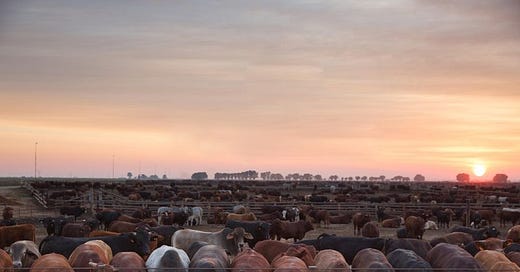Animal Disease Disrupt the Export Recovery Path of the SA Red Meat Industry
We were on a recovery path
We are halfway through 2025, and if you were to ask any cattle farmer in South Africa, how has the year been? They will likely tell you that this has been a financially challenging year for the industry.
But at the start, the outlook looked promising. We thought the industry would continue its recovery from last year, benefiting from improvements in grazing veld and relatively lower feed prices. This was after the better summer rains improved agricultural conditions across the country.
The export markets had also opened up from the second half of 2024, following temporary closures in the previous year due to the industry's impact from the foot-and-mouth disease outbreak in most provinces. For example, in 2024, South Africa's cumulative beef exports increased by 30% from 2023, reaching 38,657 tonnes. About 57% of this was fresh beef, and 43% was frozen beef. The key markets include China, Egypt, UAE, Jordan, Angola, Mozambique, Kuwait, Qatar, Saudi Arabia, and Mauritius, amongst others.
However, the recent outbreak of foot-and-mouth disease on a few farms in various regions of South Africa presented additional challenges, leading to temporary closures of export markets again in an industry that was still on its recovery path. The financial pressures on farmers are immense, and we will have clarity about the scale in the coming months.
What has now been encouraging is the collaboration between the Department of Agriculture and organised agriculture in containing the disease and facilitating vaccination on the affected farms. We can expect the vaccination process to gain momentum in the last week of June 2025.
However, the key to the long-term success of the industry lies in improving animal health, developing vaccines domestically, and implementing better surveillance, among other interventions. Efforts on this vital issue should continue through the collaboration of various stakeholders, including the government, the private sector, and organised agriculture, among others. South Africa must leverage existing private sector expertise as the process to improve state-owned facilities, such as the Onderstepoort Biological Products (OBP), a state-owned vaccine manufacturer, is underway. We no longer need just one centre of manufacturing but more where capabilities exist.
This intervention is key not only for preserving the country's share of the industry but also for creating room for new entrant farmers. It is hard to talk about the integration of black farmers into commercial value chains when the risks of diseases remain high and can be financially devastating to businesses.
The recent statements by South Africa's Agriculture Minister, Mr John Steenhuisen, on various occasions regarding the department's commitment to strengthening animal and plant health are encouraging.
Indeed, in the near term, the focus is on vaccination; however, beyond that process, we must adopt a careful approach to reviving domestic vaccine manufacturing capabilities and involve the private sector. Thereafter, also nudge the Department of Public Works and Infrastructure to assist with fencing to ensure the strict control of animal movement in the country.
In the former homelands regions of South Africa, the traditional leaders have an essential role to play in managing the movement of livestock. The task cannot be left solely to the government. Everyone has a role to play in ensuring that South Africa's animal health is a priority.
The livestock industry is an anchor of the South African farming economy. The livestock and poultry industries account for nearly half of our agricultural fortunes, with significant contributions by black farmers as part of the inclusive growth agenda.
As I have noted in the past, while we now struggle with foot-and-mouth disease, what we have learned from recent experience is that this may not be the last outbreak, and there may be future outbreaks of various diseases in other value chains.
South Africa, more than ever, should increase its investment in animal health by allocating better resources to infrastructure and human capital. We also need a similar focus on plant health. This means biosecurity – animal and plant health -- is entirely more important than ever and is at the heart of any thriving farming economy.






how do you think the government should approach promoting active biosecurity measures to traditional leaders in the homeland regions?
Would it be feasible for them to incentivise active monitoring systems that would paint a clearer picture of the situation across the country?
How can the rollout of biosecurity monitoring hubs be approached at a regional level that would ensure active participation from research institutions and universities?
Should it be tied to promoting student involvement in the biosecurity sector to improve the future attitude of farmers toward proper management? (i.e. pushing more students to explore biosecurity as a career or just giving them the knowledge to identify certain shortfalls across the supply chain)